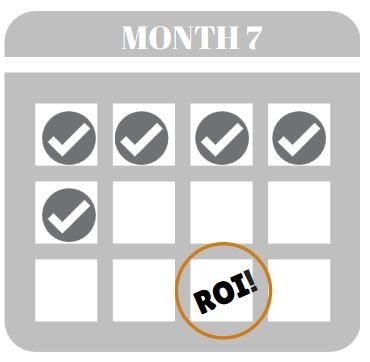
As an inbound marketing agency, one of the questions we’re asked most often is, “When can I expect to see an ROI on my investment in inbound marketing?”
As we talked about in “4 Key Factors That Impact Results”, the speed with which you see a return depends on your commitment level, the current state of your marketing and your budget. We’ve also shared “Why Inbound Marketing Takes 12 Months”, outlining the process and showing how inbound marketing must build results naturally over time.
Every campaign is a little bit different, but we thought it might be useful to map out what a typical campaign might look like on a 12-month timeline to give you some idea of the activities, deliverables and ROI you could expect to see.
Month 1
This is one busy month! Your campaign kicks off with a lot of questions and research. In the first month:
- We’ll survey your business and learn as much as we can about your product/service, brand and operations
- Strategies are assembled
- Benchmarks and goals will be set
- Personas are built and documented
- Content audits are used to find gaps and opportunities
- Editorial calendars are put together
Month 1 is a kickoff month, where the foundation is set for everything that’s to come.
Month 2
In this month, the wheels start turning. Onsite changes to information architecture, content, title tags and more are implemented, helping your site become search engine friendly and improving your organic targeting.
Typically, this is also the first month you’ll publish pieces from the editorial calendar, depending on your need. This is a time to test out your style guides and make sure the content being produced is in line with your expectations of quality, the tone and voice of your brand and that it’s all being tied back to your overarching business goals.
Month 3
Now that the editorial calendar is humming along, attention can be turned towards your social media and promotional outlets. Extra effort might be put into helping you engage with your audience and build a community in order to improve the reach of the content that’s coming further down the line.
In addition, small conversion rate optimization tests will be cued up, collecting data that will help to find the most effective landing pages and calls-to-action in a few months’ time.
At this point, businesses may start noticing small increases in the number of leads they’re receiving.
Month 4
Around this time, attention may be put on building permanent assets to help generate and qualify incoming leads. In addition to the pieces being published to the blog, this might include eBooks, white papers or guides.
By now you’ll have a really good sense of whether or not the personas you’ve created for your project are true-to-life and effectively capture your market, using analytics data to refine and improve the content you’re creating.
Month 5
By month 5, most companies have gathered enough onsite data to have a statistically significant understanding of which landing page variants, calls-to-action and other conversion factors. You’ll also have a pretty clear picture of how people are interacting with your website content.
Using that data, recommendations to improve your conversion funnel will be made and implemented. Content marketing efforts continue, and by now you’ll have noticed significantly higher levels of engagement on social media and across online communities.
Month 6
By month 6, all the different pieces are moving in full-time. Content is steadily being produced, landing pages are being refined on an ongoing basis and permanent assets are seeing significant uptake. Your sales team is seeing a lot more leads in the funnel, and notes that the leads are also more qualified, making it easier to close the deal.
Your website is really going to work for you, converting more visitors than ever before thanks to a well-defined and optimized conversion process that’s always being reviewed and improved.
Around months 5 – 6 is when some campaigns introduce email drip and marketing campaigns, as there’s usually enough content being produced to sustain them and enough of an audience to warrant the effort. With some clients who start off with a larger audience, these activities happen earlier (month 3 0 4). These efforts are invaluable for nurturing leads, and can have an immediate impact on sales numbers, too.
Month 7
By this point, nearly 50% of companies using inbound marketing have seen a marked increase in sales. (Tweet This)
Month 7 is the month where most companies start to really see their investment paying off in a tangible way, beyond engagement numbers, traffic and leads. In month 7, it may come time to talk about your internal on boarding processes and make sure you have the capacity to handle the influx of leads.
Some clients also opt to ramp up efforts at this point, increasing the budget thanks to the revenues from new sales.
Months 8 – 11
In the months that follow that pivotal 7-month point, it’s all about measuring, refining and improving.
Digging into the numbers will reveal:
- The kinds of content, topics and themes that perform best at every stage of the funnel
- The key influencers, hubs and outlets driving traffic to your website, and the kinds of content they like to share
- The best-converting landing pages and strongest lead-driving assets
- Bottlenecks and hiccups in the sales process that can be removed or improved, whether on or offline
- The average cost of your leads and sales, and opportunities to reduce those costs
Through these months, you should continue to see a steady increase in traffic, leads and ultimately, sales.
Month 12
Although inbound marketing campaigns are constantly being reviewed and improved, your campaign’s one-year anniversary reflects a time to sit down, pour over the numbers and see whether or not you’ve hit the benchmarks and goals set at the beginning (or often, how much you surpassed them!)
By month 12, you should have a robust collection of content to draw from and a presence across multiple channels, whether it’s your blog, e-mail newsletters, permanent assets or social media. Your community should be growing naturally and on its own, with content advocated who anticipate and enjoy sharing your content.
Month 12 is a time to set new goals, determine priorities for the coming year and decide what areas of your campaign ought to be given the most attention in order to sustain and improve returns.
One year could make all the difference for your business.
Inbound marketing could change the way you do business for the better in less than a years’ time. As noted, most businesses start seeing notable sales increases in 7 months or less – and because of the nature of inbound marketing, those results only grow with time!
And there you have it. This timeline is only what a typical campaign might look like – yours will be tailored exactly to your need, audience, budget and starting point. That said, with marked and sustained returns after 7 months or less, the question isn’t whether you can afford to invest in inbound marketing – it’s whether you can afford not to.










